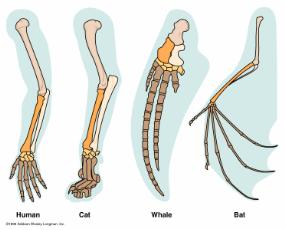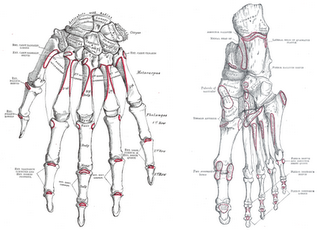Homology in the mind
Here is an attempt at trying to spell out the logic of mental modules, and what they might mean, through something more apparent: anatomy.
Ok, so those of us that believe in evolution, quite like homologous organs. Essentially, several people (including Darwin) saw in the anatomy of animals, certain common forms.
 In this pic, homologous bones are painted in like colors. And you don't need terribly lots of imagination to see that there are similar (same) number of bones, which are arranged in similar ways, with obvious differences.
The point is that these differences reflect the different functions of the organs (hands, paws, flippers, batwings).
In this pic, homologous bones are painted in like colors. And you don't need terribly lots of imagination to see that there are similar (same) number of bones, which are arranged in similar ways, with obvious differences.
The point is that these differences reflect the different functions of the organs (hands, paws, flippers, batwings).
 Just looking at the picture of the bones, its quite plain that there are a great deal of similarities. In fact, at structural level, one might say that, by and large, the hand and the foot are made up of pretty similar things. But, from this, if you were to draw the conclusion that the hand and the foot did very similar things, you would be in error. So:
Just looking at the picture of the bones, its quite plain that there are a great deal of similarities. In fact, at structural level, one might say that, by and large, the hand and the foot are made up of pretty similar things. But, from this, if you were to draw the conclusion that the hand and the foot did very similar things, you would be in error. So:
 In this pic, homologous bones are painted in like colors. And you don't need terribly lots of imagination to see that there are similar (same) number of bones, which are arranged in similar ways, with obvious differences.
The point is that these differences reflect the different functions of the organs (hands, paws, flippers, batwings).
In this pic, homologous bones are painted in like colors. And you don't need terribly lots of imagination to see that there are similar (same) number of bones, which are arranged in similar ways, with obvious differences.
The point is that these differences reflect the different functions of the organs (hands, paws, flippers, batwings).
Lesson 1:
Although different animals might share similar underlying elements, this alone cannot explain the function in the different animals This point, translated into Cognitive Science would run something like this: simply finding some basic computational mechanism in two animals does not necessitate that they are used in like ways and for like functions. This is essentially the crux of some of the arguments in Pinker & Jackendoff, part I (amongst many others). But there is something else. If you think about the human hand you see above; there is another organ that looks way more similar; here is a pic of the human hand and the human foot: Just looking at the picture of the bones, its quite plain that there are a great deal of similarities. In fact, at structural level, one might say that, by and large, the hand and the foot are made up of pretty similar things. But, from this, if you were to draw the conclusion that the hand and the foot did very similar things, you would be in error. So:
Just looking at the picture of the bones, its quite plain that there are a great deal of similarities. In fact, at structural level, one might say that, by and large, the hand and the foot are made up of pretty similar things. But, from this, if you were to draw the conclusion that the hand and the foot did very similar things, you would be in error. So:


0 Comments:
Post a Comment
<< Home